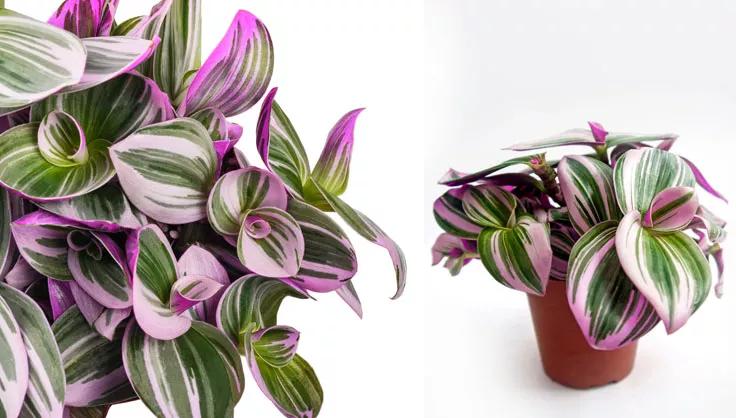How to Care for Tradescantia Nanouk

Recommended Types
The standard Tradescantia Nanouk is an excellent choice for its vivid coloration and robust growth. Other Tradescantia species like T. zebrina or T. fluminensis also offer beautiful foliage but with different color patterns.
How to Care for Tradescantia Nanouk
Caring for Tradescantia Nanouk is straightforward, making it an excellent choice for gardeners of all levels. Here's your guide to keeping your Nanouk healthy and thriving:
Light
Tradescantia Nanouk thrives in bright, indirect sunlight. It can tolerate some direct sunlight, but too much can bleach the leaves, so moderation is key.
Soil
A well-draining potting mix is ideal. You can use a standard houseplant soil mix with added perlite or coarse sand to improve drainage.
Fertilizing
Feed your Nanouk with a balanced, water-soluble fertilizer every month during the growing season (spring and summer).
Watering
Water when the top inch of soil feels dry to the touch. These plants prefer consistent moisture, but be careful not to overwater as this can lead to root rot.
Pruning
Regular pruning can help keep your Tradescantia Nanouk bushy and full. Simply trim back the long, leggy stems as needed.
Repotting
Repot your Nanouk every 1-2 years, or when it outgrows its pot. Choose a container that’s slightly larger than the current one.
Propagation
Tradescantia Nanouk is easy to propagate. Simply cut a stem below a node, remove the bottom leaves, and place it in water or soil. It will quickly develop roots and can be planted as a new specimen.
Common Problems with Tradescantia Nanouk
While Tradescantia Nanouk is relatively hardy, it can encounter some issues:
Pests and Diseases
Look out for common pests like spider mites and aphids. Regularly inspect the leaves, and treat any infestations with insecticidal soap or neem oil.
Toxicity
Tradescantia Nanouk is toxic to pets if ingested, so it's best to keep it out of reach of curious animals.
Tradescantia Nanouk FAQs
How can I maintain the vibrant colors of my Tradescantia Nanouk?
Ensure it receives plenty of bright, indirect light. Lower light levels can result in less vibrant foliage.
Can Tradescantia Nanouk be grown outdoors?
Yes, it can be grown outdoors in warm climates, but it's primarily an indoor plant. If you do put it outside, make sure it's in a spot that gets partial shade to prevent sunburn.
Why are the leaves of my Tradescantia Nanouk turning brown?
Brown leaves can be a sign of underwatering or too much direct sunlight. Adjust your watering schedule and light exposure accordingly.
Tradescantia Nanouk is a delightful and colorful addition to any indoor plant collection. Its ease of care and striking appearance make it a joy to grow for both beginner and experienced gardeners. With the right care, your Nanouk will flourish and brighten up your space with its unique and vibrant foliage.
Print this Article:
Get the Dirt
Stay up to date on new articles and advice. Please fill out the information below.
